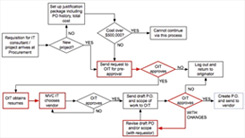Work Flow Mapping
Work-flow (process) mapping is one of the fastest ways to lower errors, increase productivity, and affect customer service. It generally follows these steps:
 Choose a process. You have to first decide what you want to improve — buying services, handling a customer’s repair order, registering students at a college, etc. Start with a process which is time-consuming or error-prone; starting where there is strong potential for improvement will build morale and help launch later mapping projects.
Choose a process. You have to first decide what you want to improve — buying services, handling a customer’s repair order, registering students at a college, etc. Start with a process which is time-consuming or error-prone; starting where there is strong potential for improvement will build morale and help launch later mapping projects.
Assemble a team. Include people from the lowest and highest levels directly involved in the operation, such as customer service agents, their supervisors and managers, and the head of operations. The team must be empowered (given the responsibility and sufficient authority or leeway) to make significant changes in the work flow.
Map out the way work is currently done. Diagram each step, showing decision branches, time spent, any distances traveled or people contacted, and other important aspects of the work. It is often be easier to sketch out the individual tasks first, then go back and fill in the details.
Identify problem areas. These are areas where people feel there are currently major issues to be resolved, such as poor customer satisfaction, “dropping the ball,” large expenses, or significant delays. Where there are many areas to choose from, try to follow the 80/20 rule: work on the 20% of the areas that cause 80% of the problems.
Brainstorm solutions. Identify all possible action steps for each problem area, without evaluating them.
Evaluate action steps. Set up a set of “final” action steps by group consensus.
Assign responsibilities. Ask people to volunteer to take responsibility for each action step judged to be worthwhile by the group, and to set deadlines.
Create a master plan. Summarize who has responsibility for what actions and the deadlines. Distribute the plan and make sure everyone agrees with it and that it accurately reflects the decisions made during the sessions.
Follow through. The meetings are useless without appropriate follow-through. Try meeting again every two weeks to see what went well and what did not. When the time is right, try having another brainstorming session. This is where having a detailed, clear, and well communicated master plan is invaluable.
To be effective, work flow mapping should be facilitated by an experienced process consultant. Our role is to help you through the process and to work on the interpersonal issues that can get in the way of effective problem-solving.
See other tools • For schools and colleges
Copyright © 2001-2024, Toolpack Consulting, LLC. All rights reserved.
